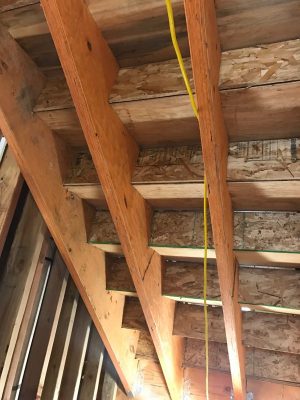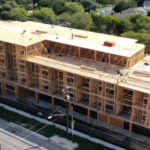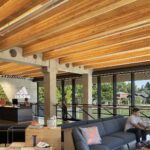Expert Tips
Material and FRR Requirements for Stairs and Landings
Outlines requirements for stairway construction and horizontal building separation allowance in the International Building Code (IBC).

IBC 2015 Section 1011.7 provides this information on the construction of stairs:
1011.7 Stairway construction.
Stairways shall be built of materials consistent with the types permitted for the type of construction of the building, except that wood handrails shall be permitted for all types of construction.
This indicates that, where the use of combustible materials is not limited—i.e., Types III and V Construction—light wood framing can be used to frame stairs and landings. Heavy timber framing can be used to frame stairs in Type IV buildings, which allow heavy timber for all interior framing including floors. There are no specific fire-resistance rating requirements for stair and landing framing. This is corroborated in the code commentary to Section 1011.7:
In keeping with the different levels of fire protection provided by each of the five basic types of construction designated in Chapter 6, the materials used for stairway construction must meet the appropriate combustibility/noncombustibility requirements indicated in Section 602 for the particular type of construction of the building in which the stairway is located. This is required whether or not the stair is part of the required means of egress. Any structure supporting the stairway and the stairway enclosure must be fire-resistance rated consistent with the construction type; however, the stairway components inside the enclosure need only comply with the material limits for the type of construction.
In mid-rise structures, the use of the horizontal building provision (commonly called podium or pedestal style buildings) in IBC 510.2 is common. When the building above the podium is Type III, IV or V, the portion of the stair shaft and framing above the podium can therefore be framed in wood. However, a common question is whether or not the stair framing below the podium may also be framed with wood. To address this, it is useful to look at the provisions of IBC Section 510.2 (the podium provision):
510.2 Horizontal building separation allowance.
A building shall be considered as separate and distinct buildings for the purpose of determining area limitations, continuity of fire walls, limitation of number of stories and type of construction where all of the following conditions are met…
One of the conditions here is that the building below the horizontal assembly is of type IA Construction. Type IA is required to be framed with non-combustible materials and no exceptions to this exist in IBC Section 603 that would apply to stair framing and/or floor framing. Based on these code sections, some Authorities Having Jurisdiction (AHJ) require that the stair construction below the podium be framed with non-combustible materials. However, a conversation with the AHJ on this topic is often beneficial as some have acknowledged that requiring the stair below the podium to be non-combustible while all of the stair framing above the podium (which is part of the same stair shaft) is combustible would not change the fire safety of the shaft enclosure. The code commentary to IBC 713.1 notes that “The purpose of shafts is to confine a fire to the floor of origin and to prevent the fire or the products of the fire (smoke, heat and hot gases) from spreading to other levels.” The baseline assumption is that fires start within the main portion of a building rather than within the shaft. This may be seen as a reason that no fire-resistance rating requirements exist for stairway construction. With this in mind, some designers have successfully been permitted to utilize wood framing in stair construction both above and below the podium line in podium style buildings.
In recognition of this common design scenario, a code change has been approved that will be incorporated in the 2021 IBC, allowing combustible stair framing in the podium level of buildings where the building above the podium is of Type III, IV or V construction. Below is how IBC Section 510.2 will be revised for the 2021 IBC; new information is underlined.
2018 International Building Code
Revise as follows:
510.2 Horizontal building separation allowance. A building shall be considered as separate and distinct buildings for the purpose of determining area limitations, continuity of fire walls, limitation of number of stories and type of construction where all of the following conditions are met:
- The buildings are separated with a horizontal assembly having a fire-resistance rating of not less than 3 hours. Where vertical offsets are provided as part of a horizontal assembly, the vertical offset and the structure supporting the vertical offset shall have a fire-resistance rating of not less than 3 hours.
- The building below, including the horizontal assembly, is of Type IA construction.
- Shaft, stairway, ramp and escalator enclosures through the horizontal assembly shall have not less than a 2-hour fire-resistance rating with opening protectives in accordance with Section 716.Exception: Where the enclosure walls below the horizontal assembly have not less than a 3-hour fire-resistance rating with opening protectives in accordance with Section 716, the enclosure walls extending above the horizontal assembly shall be permitted to have a 1-hour fire-resistance rating, provided:
- The building above the horizontal assembly is not required to be of Type 1 construction;
- The enclosure connects fewer than four stories; and
- The enclosure opening protectives above the horizontal assembly have a fire protection rating of not less than 1 hour.
- Interior exit stairways located within the Type IA building are permitted to be of combustible materials where both of the following requirements are met:4.1 The building above the Type IA building is of Type III, IV, or V construction.
4.2 The stairway located in the Type IA building is enclosed by a 3-hour fire-resistance rated construction with opening protectives in accordance with Section 716.


